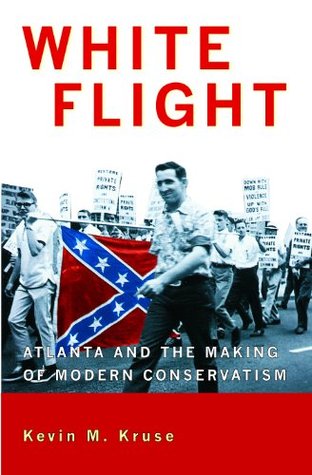More on this book
Community
Kindle Notes & Highlights
Read between
September 19 - October 2, 2019
And he told us, without the slightest blinking of an eye, that we’d get black police about as soon as we’d get deacons in the [white] First Baptist Church.”
In his private racism and paternalism, Hartsfield simply echoed the attitudes of his business allies. As Floyd Hunter found in his study of Atlanta’s “power structure,” many businessmen who appeared racially progressive in public were decidedly less so in private. “I’m a true friend of the Negro,” one man told him, “and will be, as long as he keeps his place.” Like the mayor, many of these businessmen adopted a public image of racial moderation that was strongly at odds with their personal racism.
As Atlanta’s affluent whites understood, their main concerns—the stability of their city and the success of their businesses—would be damaged by acts of racial extremism. Forced to choose between the social customs of segregation and the economic creed of progress, they readily chose the latter.
Close analysis of voting results made it clear that working-class whites, who sided the most consistently with segregation, were in fact a lost cause. In the 1953 primary, for instance, Hartsfield received 90 percent of all votes cast in a typical black precinct and 60 percent in a typical upper-income white precinct, but just 29 percent in a precinct of lower-income whites.
Practically speaking, this meant working along segregated lines. “There are really two real estate markets—one Negro and one white,” the WSMDC conceded in 1958. This resulted not from any public policy of segregation, the committee claimed, but rather from private preferences. According to the WSMDC’s technical adviser, Robert Stuart, “the decisions of thousands of individual buyers and sellers of property exercising their constitutional rights [are what] determines whether a particular area is white or Negro.” From its own perspective, the WSMDC merely sought to clear up confusion and prevent
...more
Race was never mentioned. Instead, it existed as an unspoken undercurrent throughout the discussion of creating “a desirable community.” For white Atlantans, only an all-white community was desirable.8
As neighbors saw the “For Sale” signs, reports began circulating that those streets had been “zoned for colored citizens” by the city. To dispel rumors, the WSMDC polled homeowners.
With the neighborhood externally abandoned and internally divided, the Adair Park Civic Club became paralyzed. Lacking funds to buy back all the homes, it tried to forge a compromise with black real-estate agents. Properties on Mayland Avenue would be repurchased by the white homeowners’ organization, and, in exchange, blacks would be granted a “free hand” along the rest of Mayland Circle. But, as Jim Parham observed, the negotiations were “undermined” by die-hard resisters “who criticize every move to compromise short of ‘saving’ the entire area.”
white people only.”
Believing that “community” was meaningless when it mattered most, they moved toward a new ideology that was its antithesis—individuality. As the course of desegregation spread from their neighborhoods to their neighborhood institutions, the trend toward isolation and individualization would only increase.
The drop-off in white usage, however, was not due to the actual desegregation of the buses but their threatened desegregation. The ministers’ lawsuit took two years to work its way through the court; meanwhile, they urged blacks to abide by segregated seating patterns. Apparently, they did. An Atlanta University sociology student rode the buses in April and May 1957, for instance, and found that the old patterns of segregation persisted. “Of the total number of white passengers riding the buses, the largest number preferred to sit from ‘front to center,’ ” he noted on a rush hour bus. “Whites
...more
Segregationists were outraged. Blacks did not want equality, they charged; they wanted social intimacy.
This supposed disparity between the tax burdens of whites and blacks took on a strongly racist tone, as whites charged that they unfairly bore the financial burden for a welfare system that catered to blacks. “I believe in them having good things but in their own negro sections and I believe in them working by the sweat of their brow as ‘God’ states in the Bible instead of hand-outs from White organizations,” one man complained. “Welfare office, etc. give them about $50 of white peoples tax money for every illegitimate ‘youngster’ they have & do they breed fast?” “A majority of negro women
...more
Not surprisingly, as school desegregation picked up speed, white flight kept pace. In early 1964 the Atlanta Board of Education responded to pressure from federal courts and greatly accelerated its plans for integration in the upcoming school year. No longer would white facilities remain unused, while black schools became dangerously overcrowded. “We’re going to fill every empty seat in high school classrooms this fall,” board member Sara Mitchell announced in April. Transfers, which had heretofore been tightly limited, were suddenly granted in great numbers. While only 85 requests had been
...more
Over the course of the 1960s, as student activists became ever more strident and white businessmen responded in kind, the political coalition that had once held them together seemed dangerously close to falling apart. Black Atlanta became embroiled in a generational conflict that threatened to push the two sides ever farther apart. Meanwhile, the white business elite found itself increasingly at odds with its longtime political allies, and increasingly tempted to join forces with the segregationists it had helped suppress for the better part of two decades. The sit-ins thus represented more
...more


